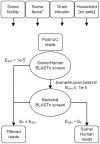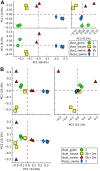Shotgun pyrosequencing metagenomic analyses of dusts from swine confinement and grain facilities
- PMID: 24748147
- PMCID: PMC3991671
- DOI: 10.1371/journal.pone.0095578
Shotgun pyrosequencing metagenomic analyses of dusts from swine confinement and grain facilities
Abstract
Inhalation of agricultural dusts causes inflammatory reactions and symptoms such as headache, fever, and malaise, which can progress to chronic airway inflammation and associated diseases, e.g. asthma, chronic bronchitis, chronic obstructive pulmonary disease, and hypersensitivity pneumonitis. Although in many agricultural environments feed particles are the major constituent of these dusts, the inflammatory responses that they provoke are likely attributable to particle-associated bacteria, archaebacteria, fungi, and viruses. In this study, we performed shotgun pyrosequencing metagenomic analyses of DNA from dusts from swine confinement facilities or grain elevators, with comparisons to dusts from pet-free households. DNA sequence alignment showed that 19% or 62% of shotgun pyrosequencing metagenomic DNA sequence reads from swine facility or household dusts, respectively, were of swine or human origin, respectively. In contrast only 2% of such reads from grain elevator dust were of mammalian origin. These metagenomic shotgun reads of mammalian origin were excluded from our analyses of agricultural dust microbiota. The ten most prevalent bacterial taxa identified in swine facility compared to grain elevator or household dust were comprised of 75%, 16%, and 42% gram-positive organisms, respectively. Four of the top five swine facility dust genera were assignable (Clostridium, Lactobacillus, Ruminococcus, and Eubacterium, ranging from 4% to 19% relative abundance). The relative abundances of these four genera were lower in dust from grain elevators or pet-free households. These analyses also highlighted the predominance in swine facility dust of Firmicutes (70%) at the phylum level, Clostridia (44%) at the Class level, and Clostridiales at the Order level (41%). In summary, shotgun pyrosequencing metagenomic analyses of agricultural dusts show that they differ qualitatively and quantitatively at the level of microbial taxa present, and that the bioinformatic analyses used for such studies must be carefully designed to avoid the potential contribution of non-microbial DNA, e.g. from resident mammals.
Conflict of interest statement
Figures






References
-
- Von Essen S, Donham K (1999) Illness and injury in animal confinement workers. Occupational Medicine 14: 337–350. - PubMed
-
- Donham KJ, Reynolds SJ, Whitten P, Merchant JA, Burmeister L, et al. (1995) Respiratory dysfunction in swine production facility workers: dose-response relationships of environmental exposures and pulmonary function. American Journal of Industrial Medicine 27: 405–418. - PubMed
-
- Donham KJ, Zavala DC, Merchant J (1984) Acute effects of the work environment on pulmonary functions of swine confinement workers. Am J Ind Med 5: 367–375. - PubMed
-
- Larsson KA, Eklund AG, Hansson LO, Isaksson BM, Malmberg PO (1994) Swine dust causes intense airways inflammation in healthy subjects. Am J Respir Crit Care Med 150: 973–977. - PubMed
-
- Malmberg P, Larsson K (1993) Acute exposure to swine dust causes bronchial hyperresponsiveness in healthy subjects. Eur Respir J 6: 400–404. - PubMed
Publication types
MeSH terms
Substances
Grants and funding
LinkOut - more resources
Full Text Sources
Other Literature Sources

